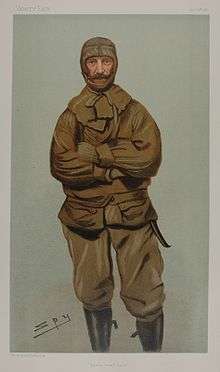Frederick George Jackson


Frederick George Jackson (6 March 1860 – 13 March 1938) was a British Arctic explorer remembered for his expedition to Franz Josef Land, when he located the missing Norwegian explorer Fridtjof Nansen.
Life and career
He was born the son of George Frederick and Mary Elizabeth Jackson at Alcester Lodge, Alcester, Warwickshire, England and educated at Denstone College in Staffordshire and Edinburgh University.[1]
His first voyage in Arctic waters was on a whaling cruise in 1886–1887, and in 1893 he made a sledge-journey of 3000 miles across the frozen tundra of Siberia lying between the Ob and the Pechora. His narrative of this journey was published under the title of The Great Frozen Land (1895).[2]

On his return, he was given the command of the Jackson-Harmsworth Arctic expedition (1894—1897). Sponsored by the Royal Geographical Society, this expedition was to conduct general exploration of Franz Josef Land. Whilst leading this expedition, Jackson and his men were contacted on 17 June 1896 by the Norwegian arctic explorer Fridtjof Nansen and his companion Hjalmar Johansen, who had not been heard of for three years and were presumed dead, but were in fact trying to reach Spitsbergen by kayak. Jackson informed him that they were in fact on Franz Josef Land, and with Jackson's help, Nansen and Johansen were able to return home, departing aboard the Windward on 7 August. Jackson and his party wintered at their camp according to plan.[3] The Jackson-Harmsworth expedition proved that Franz Josef Land is nothing more than an archipelago of small islands.[4]
In recognition of his services he received a knighthood of the first class of the Norwegian Royal Order of St Olaf in 1898, and was awarded the gold medal of the Paris Geographical Society in 1899. His account of the expedition was published under the title of A Thousand Days in the Arctic (1899).
He served in South Africa with the 5th (Militia) Battalion, Manchester Regiment, during the Second Boer War, reaching the rank of Captain.[5] He transferred to the 4th Battalion, East Surrey Regiment in 1905, serving in the First World War and reaching the rank of Major. He resigned his commission in 1917. After being invalided home he commanded Southwark Recruiting District for two years followed by commands of a number of prisoner of war camps in Germany.
His travels also include a journey across the Australian deserts.
He is buried in the churchyard of St Michael and St Mary Magdalene at Easthampstead in Berkshire, and there is a memorial plaque on the wall of the church near the font.
The plaque reads:-
In memory of
Frederick George Jackson
Major. East Surrey Regiment
Commander of the Jackson-Harmsworth
polar expedition. 1894-1897.
He discovered. mapped. and named
the greater part of Franz Joseph Land
and rescued Dr Nansen.
Died 13 March 1938 aged 78 years
Sans Peur et Sans Reproche
His memorial is in St Pauls Cathedral.
His grave is in this churchyard.
R.I.P.
One of the headlands discovered on the expedition was named St Chad's Head (Denstone College was originally called St Chad's College), and the sledge used was presented to Denstone College.[6]
See also
References
- ↑ "Frederick George Jackson (1860-1938), short biography". Retrieved 13 August 2013.
- ↑ Jackson, Frederick George (1895). The Great Frozen Land. London: Macmillan & Co.
- ↑ Nansen, Fridtjof (1897). Farthest North. vol. 2. New York: Harper & Brothers. pp. 522–577.
- ↑ Jackson, Frederick George (1899). A Thousand Days in the Arctic. vol. 2. New York: Harper & Brothers.
- ↑ "JACKSON, Capt. Frederick George". Who's Who. Vol. 59. 1907. pp. 917–918.
- ↑ The Denstonian; March 1927
External links
| Wikimedia Commons has media related to Frederick George Jackson. |
- Works by or about Frederick George Jackson at Internet Archive
-
 Chisholm, Hugh, ed. (1911). "Jackson, Frederick George". Encyclopædia Britannica (11th ed.). Cambridge University Press.
Chisholm, Hugh, ed. (1911). "Jackson, Frederick George". Encyclopædia Britannica (11th ed.). Cambridge University Press. - Frederick George Jackson, Brief bio from homepage of the Queen's Royal Surrey Regiment
- Frederick George Jackson, Entry in Archives Hub